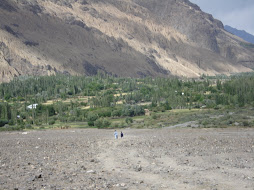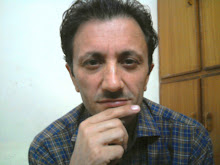Cultural practices and beliefs provide a sense of security for mothers in the aftermath of child birth in many rural areas.
According to a study conducted by Sharifa Mir of Chitral, new mothers are kept separately for some time to have less interaction with the family members. Soon after delivery, the sex of the baby is not shared with the mother because, if the baby's sex is in contrast to her expectations, there might be a number of complications, including retention of placenta. If the placenta is retained, snuff is given to the mother to inhale which induces sneezing leading to abrupt separation of the placenta.
Sometimes it leads to postpartum hemorrhage which could be fatal. In Kalash culture, women are kept in separate buildings called Bashalini (labour room) for three weeks after delivery and there is no interaction with other family members including the husband except with one woman.
Among Muslims, the concept of placing taweez and thread on the arm or around the neck is prevalent to prevent evil eye. Burning holy incense prepared from the seeds of special plants giving aromatic smoke and holding a baby in the smoke is commonly practised. Moreover, in newborn, a small incision is made between the eyebrows in order to prevent eye infections. Such surgical procedures end up in further complication like infection and scar formation.
The concept of personal hygiene also differs from culture to culture. Among Muslims, mothers avoid taking baths and shampooing hair during the first week of postnatal period as it is believed that it will increase bleeding. However, in Kalash culture, bathing is prohibited for 40 days. In both the cultures, mothers use cow dung in a form of perineal pack in order to absorb bleeding and enable them to regain the heat that they lost during delivery.
Cow dung is also used for newborn to absorb urine and stool. To treat and prevent urinary tract infections in neonates, they burn a tiny area on symphysispubis and that material is prepared by a thin layer of special plant. Application of ghee and matti (burnt walnut) on the umbilical stump is common and it is believed that it will promote early healing.
All these practices lead to neonatal tetanus (NNT). A study conducted in Africa found that annually 80 percent of NNT deaths were caused by application of cow dung to the umbilical stump and had dropped to 0-3/1000 births in intervention areas compared to 80/1000 in control areas. Statistics show that in Pakistan, 26,400 neonatal deaths are caused by NNT. Applications of ghee to the umbilical stump have been identified as risk factors in the Northern Areas.
Cultural norms also have an impact on dietary practices and to restore energy postnatal women consume high calorie diet. The concept of certain foods being `hot' and `cold' dominantly exists. In both cultures hot food is advised because they are believed to make blood thick leading to a steady flow. Wheat, milk and animal products are given alternatively to the mother. In contrast, cold foods are restricted such as chilies and bitter things are believed to make the blood thin and can increase bleeding.
Colostrums is not encouraged because it is considered old, dirty and stale can cause diarrhoea or vomiting in newborn. Some initiate first feed by giving butter and honey (ghutti) to the newborn. In contrast, Kalash people initiate breastfeeding and strongly believe that colustrum provides energy to the baby.
Cultural concepts relating to postnatal care in context of health beliefs, hygiene care and dietary practice vary from culture to culture. Becoming aware of these differences is one of the greatest challenges today for a health professional to become an effective provider of health services.
Friday, August 29, 2008
Subscribe to:
Post Comments (Atom)
Awesome and rugged

Beauty of Chitral

Kishmanja, a beautiful village in Yarkhun valley
Lush green

DIZG: threatened by floods

The legendary village of Ayun in Chitral

On way to Bumburet
Dizg, Yarkhun

Blog Archive
-
▼
2008
(197)
-
▼
August
(31)
- Culture's role in treatment of new mothers
- Infant mortality rate cut in Chitral
- Probe against revenue officer urged
- PML-Q MNA Mohiuddin joins PPP
- Few conversions in Kalash
- Truckers demand opening of Chitral-Dir road
- Chitral-Peshawar road closed at Lowari
- Compensation sought for festival's cancellation
- Community school set up in Yarkhun valley of Chitral
- Two heroes
- Wah blasts: body of Chitrali victim brought home
- 800 TB patients detected in Chitral every year
- Steps urged to reduce losses during disasters
- Position holders get cash awards
- Chitral's peace to be maintained
- Chitral forest a `windfall' for timber mafia
- Accord signed for Kalash valley uplift
- Lowari tunnel digging to complete by December
- Lowari tunnel digging to complete by December
- Plots distributed among heirs of policemen
- Plots distributed among heirs of policemen
- Chitral streets teem with garbage, where is TMA
- More girls colleges for Chitral demanded
- Chitral BHUs without doctors
- Wanted a bridge for Yarkhun valley
- TMA Chitral allocates funds for Tajikistan road
- Naib nazim resigns over minister's remarks
- Unesco urged to save ancient sites in Mastuj
- save ancient sites of Chitral
- Govt advised against Kabul route for power import
- Helicopter to the roof of the world
-
▼
August
(31)
About Me

- Zar Alam Khan Razakhel
- Village Dizg, Yarkhun valley, Chitral, Pakistan
- I blog at http://chitraltoday.net (ChitralToday) about Chitral, its people, culture, traditions and issues. I have been writing about Chitral since 2000. Chitral is a scenic valley in the extreme north-west of Pakistan.
No comments:
Post a Comment